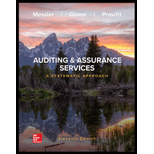
EBK AUDITING & ASSURANCE SERVICES: A SY
11th Edition
ISBN: 9781260687668
Author: Jr
Publisher: MCGRAW-HILL LEARNING SOLN.(CC)
expand_more
expand_more
format_list_bulleted
Question
Chapter 4, Problem 4.3RQ
To determine
Concept Introduction:
Audit risk is a risk that audit may provide an inappropriate opinion on the basis of his findings during the audit. There are some inherent risks and avoidable risk which result in an audit risk.
To indicate:The difference between the sampling risk and judgment errors.
Expert Solution & Answer
Want to see the full answer?
Check out a sample textbook solution
Students have asked these similar questions
Solve this finance question.
Calculate dividend using appro
What is the primary function of insurance?
explain
Chapter 4 Solutions
EBK AUDITING & ASSURANCE SERVICES: A SY
Ch. 4 - Prob. 4.1RQCh. 4 - Prob. 4.2RQCh. 4 - Prob. 4.3RQCh. 4 - Prob. 4.4RQCh. 4 - Prob. 4.5RQCh. 4 - Prob. 4.6RQCh. 4 - Prob. 4.7RQCh. 4 - Prob. 4.8RQCh. 4 - Prob. 4.9RQCh. 4 - Prob. 4.10RQ
Ch. 4 - Prob. 4.11RQCh. 4 - Prob. 4.12RQCh. 4 - Prob. 4.13MCQCh. 4 - Prob. 4.14MCQCh. 4 - Prob. 4.15MCQCh. 4 - Prob. 4.16MCQCh. 4 - Prob. 4.17MCQCh. 4 - Prob. 4.18MCQCh. 4 - Prob. 4.19MCQCh. 4 - Prob. 4.20MCQCh. 4 - Prob. 4.21MCQCh. 4 - Prob. 4.22MCQCh. 4 - Prob. 4.23PCh. 4 - Prob. 4.24PCh. 4 - Prob. 4.25PCh. 4 - Prob. 4.26PCh. 4 - Prob. 4.27PCh. 4 - Prob. 4.28PCh. 4 - Prob. 4.29PCh. 4 - Prob. 4.30PCh. 4 - Prob. 4.31PCh. 4 - Prob. 4.32P
Knowledge Booster
Similar questions
- Take value of 1.01^-36=0.699 . step by steparrow_forwardsolve this question.Pat and Chris have identical interest-bearing bank accounts that pay them $15 interest per year. Pat leaves the $15 in the account each year, while Chris takes the $15 home to a jar and never spends any of it. After five years, who has more money?arrow_forwardWhat is corporate finance? explain all thingsarrow_forward
arrow_back_ios
SEE MORE QUESTIONS
arrow_forward_ios
Recommended textbooks for you
 Auditing: A Risk Based-Approach to Conducting a Q...AccountingISBN:9781305080577Author:Karla M Johnstone, Audrey A. Gramling, Larry E. RittenbergPublisher:South-Western College Pub
Auditing: A Risk Based-Approach to Conducting a Q...AccountingISBN:9781305080577Author:Karla M Johnstone, Audrey A. Gramling, Larry E. RittenbergPublisher:South-Western College Pub Auditing: A Risk Based-Approach (MindTap Course L...AccountingISBN:9781337619455Author:Karla M Johnstone, Audrey A. Gramling, Larry E. RittenbergPublisher:Cengage Learning
Auditing: A Risk Based-Approach (MindTap Course L...AccountingISBN:9781337619455Author:Karla M Johnstone, Audrey A. Gramling, Larry E. RittenbergPublisher:Cengage Learning

Auditing: A Risk Based-Approach to Conducting a Q...
Accounting
ISBN:9781305080577
Author:Karla M Johnstone, Audrey A. Gramling, Larry E. Rittenberg
Publisher:South-Western College Pub

Auditing: A Risk Based-Approach (MindTap Course L...
Accounting
ISBN:9781337619455
Author:Karla M Johnstone, Audrey A. Gramling, Larry E. Rittenberg
Publisher:Cengage Learning